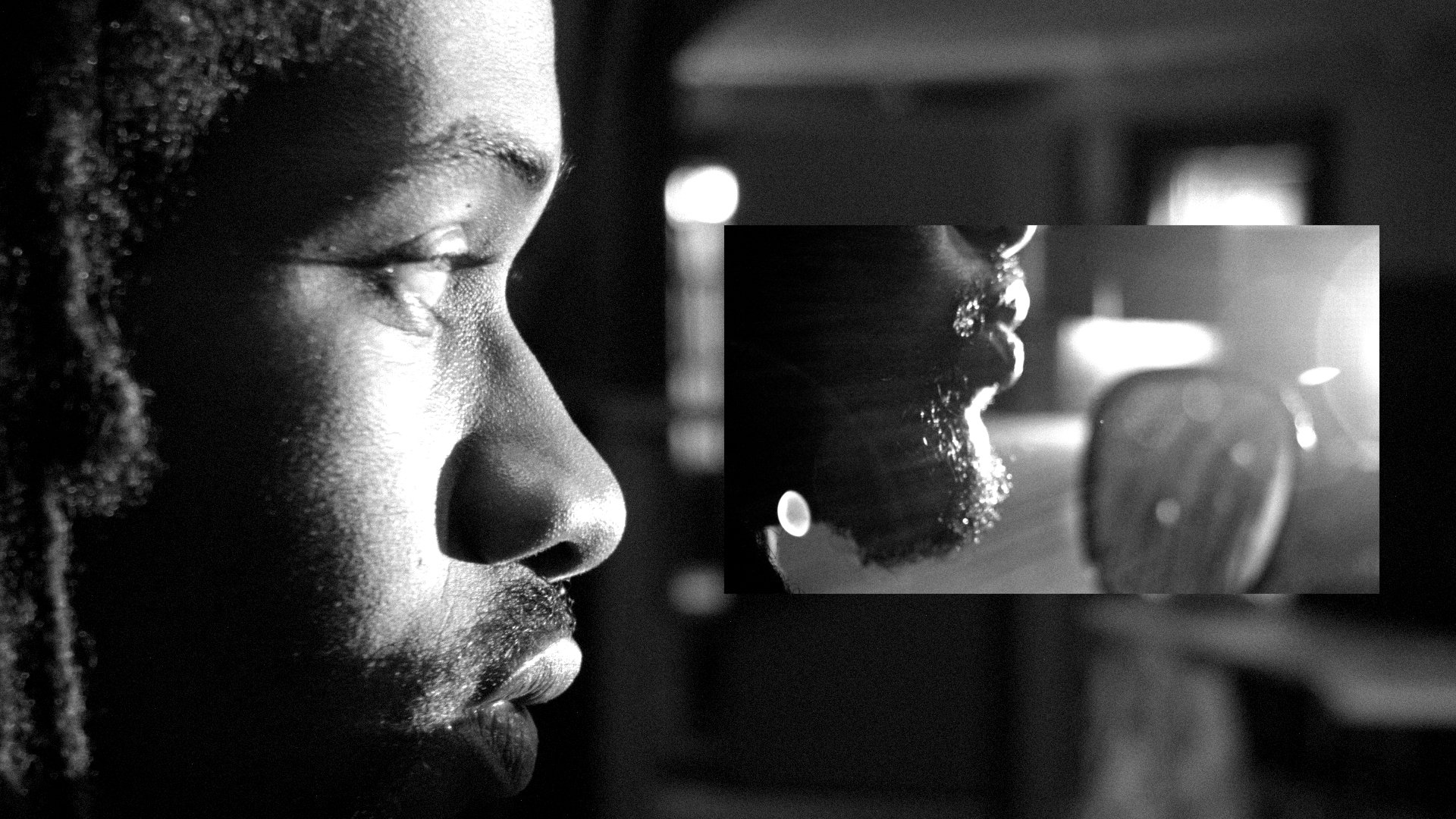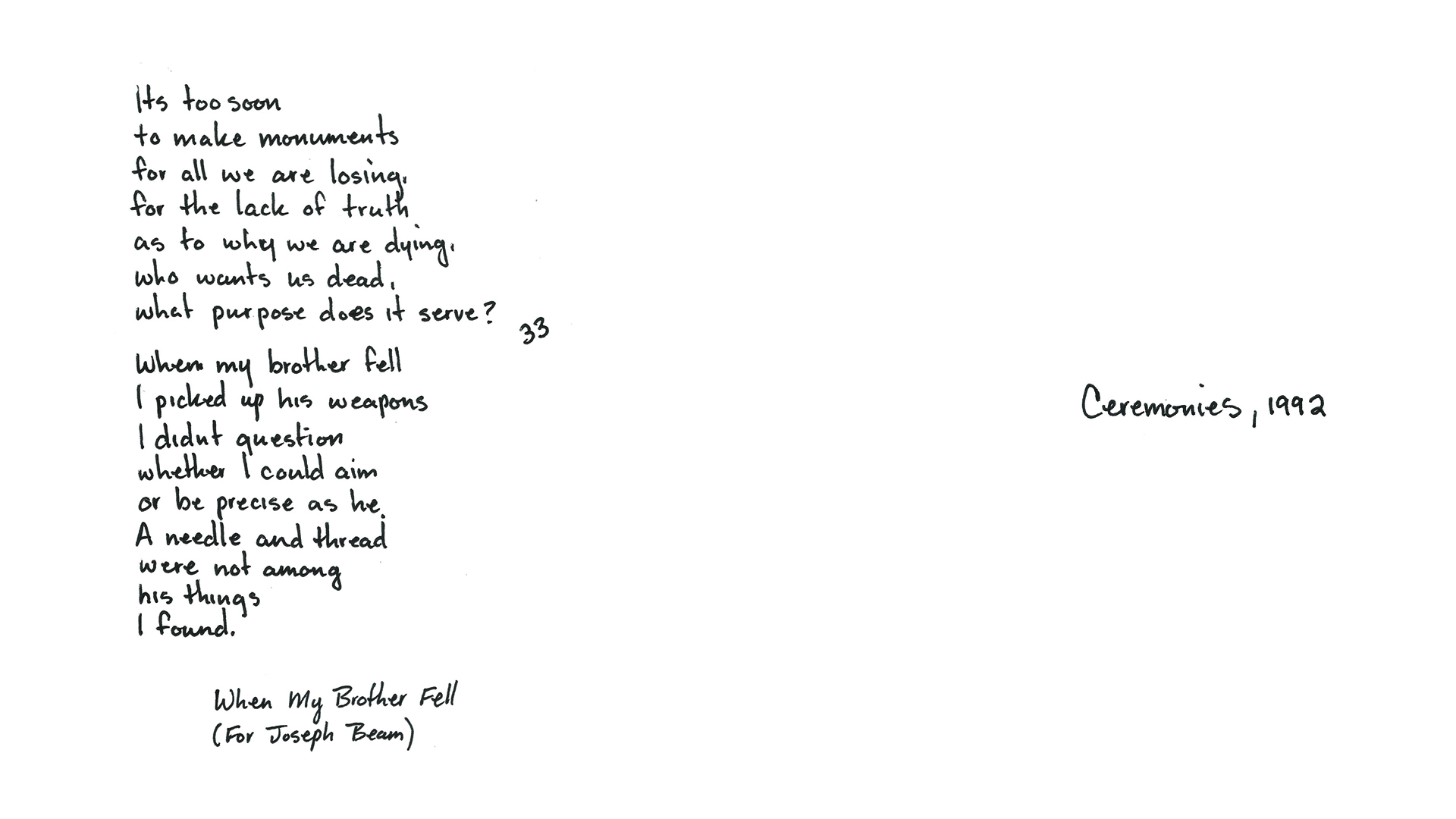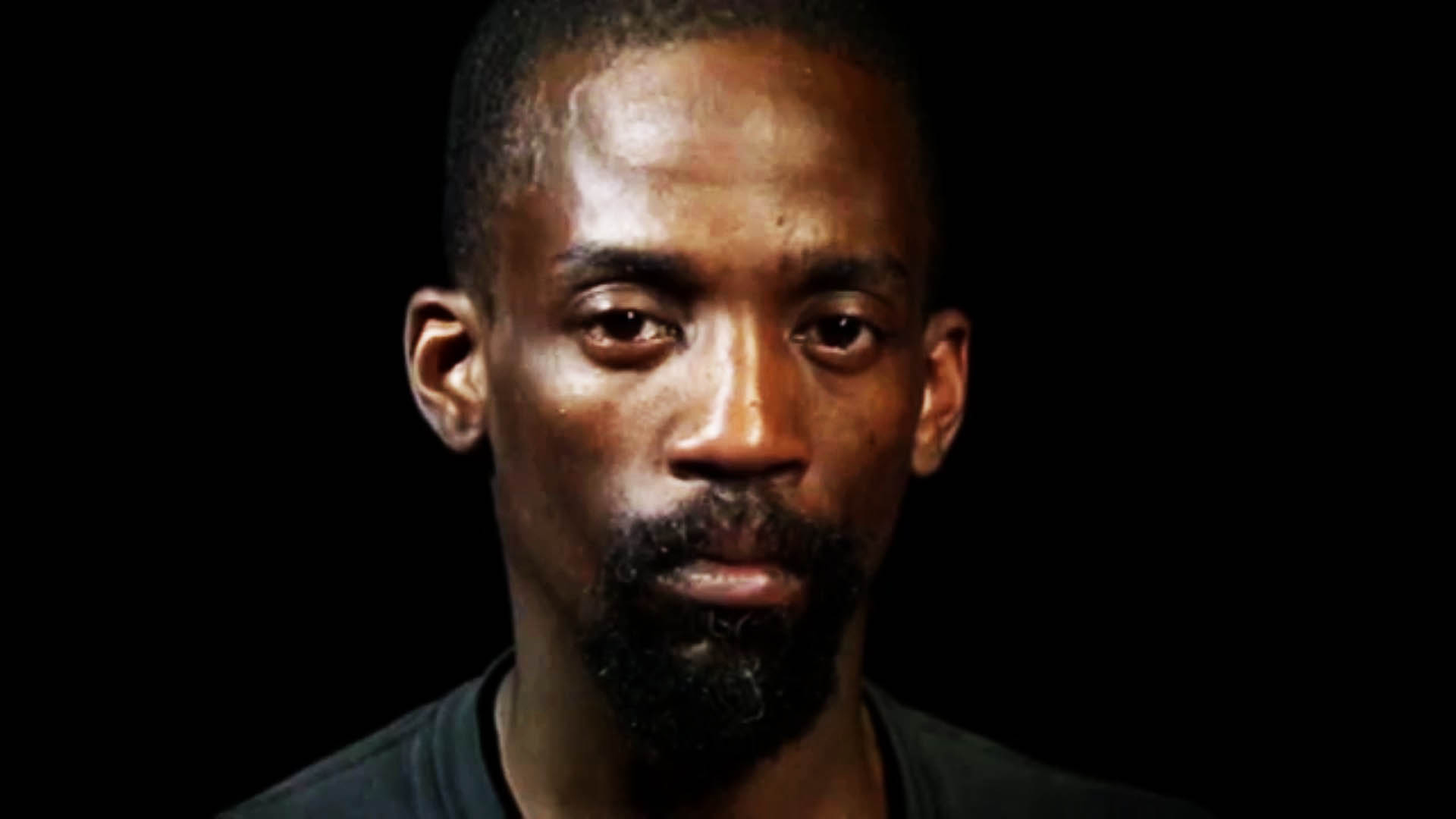
Tiona McClodden. Still image from Movement III: Can invisible men see their own reflections?, 2015. Courtesy of the artist.
Essex Hemphill was a critically acclaimed poet and activist who used his writing to address the intersections of race, gender, and sexuality. Through his work, Hemphill became an important advocate for African-American gay men, relentless in his pursuit to connect the wider, more populist rhetoric of Black Liberation at the time to an ideology that explicitly acknowledged a Black feminist and Black queer politic. Hemphill died from AIDS-related complications in 1995 at age 38.
On the occasion of the 20th anniversary of his death and to commemorate World AIDS Day, Philadelphia-based filmmaker, Tiona McClodden, was commissioned by the Institute of Contemporary Art, Philadelphia to produce the digitally based project, Affixing Ceremony: Four Movements for Essex. Rooted in Hemphill’s own theorizing about cyberspace, McClodden has used the project to invoke the poet’s spirit online. She combines texts from Hemphill’s archive with audio interviews and video to assert a renewed focus on Hemphill’s message in this contemporary moment. What follows is a conversation with McClodden about her own artistic practice, Blackness and the internet, and Hemphill’s enduring legacy.
Jessica Lynne: What was the impetus of this project about Essex Hemphill? Why him and why now?
Tiona McClodden: I was approached by the Institute of Contemporary Art (ICA), in Philadelphia, about doing a World AIDS Day project, an online commission. I almost turned it down, saying that I don’t do online work. But then I thought about it and looked at notes that I made about the Tongues Untied show at the Museum of Contemporary Art, Los Angeles, last year. Though that show was about work of Marlon Riggs—a person who has had a big influence on me as a documentary filmmaker—I was taken with Essex Hemphill and his image. Returning to my notes brought me back to Hemphill and, as I searched online, I realized that 2015 was the twentieth anniversary of his passing.
Then I found his cyberspace quote. In planning a project about someone who has died, I look for signs that point to what he or she was thinking about. Hemphill’s quote is important because it reveals him thinking about his body, his identity, and how he would be presented online. I wanted to answer, challenge, and explore these questions using his archived words.
JL: You work primarily with moving images—film, photography, music videos. How did it feel to work in this new way?
TM: It felt overwhelming. The Internet is such a vast landscape, and I was very intimidated by it as a form. But I decided that I needed to approach it as just that—a form, a medium—which meant the project’s structure came first. I knew I needed to create a structure for the work, which is how I stumbled upon the idea of using the positive symbol (+) as a casing or ritual. Rituals are important within my work: you have to go in order, you can’t skip steps, and you can’t go backwards. Such limits helped me as I thought about content—video, photo, text, and audio. Those were the elements that I felt like I could control within the structure.

Tiona McClodden. “When My Brother Fell” excerpt from Essex Hemphill’s Ceremonies. Featured text from Movement II: Will I be allowed to construct a virtual reality that empowers me?, 2015. Courtesy of the artist.
JL: How involved was the team from the ICA in this process? Did they let you just do your thing?
TM: After my original proposal, I had a meeting with the entire staff, which is unheard of, but the feedback was completely positive. They thought my idea was too much, though; they were looking for a single project. I simply told them: I make big work. Because I’m not a designer, the ICA then put me in contact with their design team so that I could be in control of the project’s structure. I created a script and, with the design team’s point person, could then think about tinkering with the site as the project developed.
JL: I keep returning to Hemphill’s theorizing about the Black body and digital space—this hyper-visible, hyper-vulnerable position. How did you reckon with his thinking from the ’90s, considering what we know about the way Blackness exists online, as you developed the project?
TM: Aside from doing research on Essex Hemphill, I explored archives of the early stages of the Internet. I remember when the Internet didn’t exist and when it came into being. I had to go back to how I negotiated my identity in the early digital space, where the body was absent. Early Internet sites were very text-heavy. One’s identity was reduced to a username, emoticons, and horrible low-resolution images. I began to think about how the Internet creates a fragmented portrait. I especially thought about Google search results as a portrait: If you looked up someone, what exists online of him or her? If I were to leave the Earth and someone looked me up, what would remain of me? The culmination of that data becomes a portrait of sorts. I thought specifically about how a Black queer icon could have such a fragmented archive in the real world.
This allowed me to consider the Internet as a big yet limited space that can be very dangerous; for this project, I was most interested in its vastness. I had to come to peace with the fact that the Internet offers a space of freedom and affirmation, even if my own relationship to it is contentious. I think there is a way to have more agency over the online presentation of self that can be safer, as it relates to Blackness and queerness and transgressive politics—the safe spaces that are allowed online that are not allowed to exist in real life.
JL: The concept of rememory [introduced in Toni Morrison’s novel, Beloved] is a theme that looms over this project and most of your work. Can you talk more about how it relates to your practice and the scholarship or research that informs your work?
TM: I think of rememory as a healthy trigger of feelings, like déjà vu or epiphany. I’m interested in developing an object or an image from a feeling. I physically revisit spaces and people and virtually revisit historical timeframes to make connections to what is happening now. To remember things, to be nostalgic, is to feel a bit of an ache. We can be very nostalgic about something and be naïve about it. Rememory is about traversing the nostalgia.

Tiona McClodden. Still image from Movement I: I’m carrying trauma into cyberspace… Courtesy of the artist.
JL: It seems to me that, beyond the mapping of Essex Hemphill and his spirit into the digital world, this project is also a gesture of love. Hemphill was constantly reminding us that love in its totality is central to what we talk about when we talk about Black liberation. How should we currently be thinking about Hemphill and his ideas on Black liberation?
TM: A couple years ago, as my work was becoming very focused on LGBTQ issues, I made it a point to get extra-Black and make an explicit gesture toward the investigation of Black revolution and liberation. I felt I had the right to investigate these histories, despite some people thinking I shouldn’t have the right because I’m a queer woman. This is where I stand. I greatly admire Essex Hemphill because that is also where he stood. He was always interested in creating a whole self—which I am also trying to do—and the core of that whole self is Blackness.
In his language, he is putting himself in these different contexts. For example, he wrote, “I die twice as fast as any other American between the ages of 18 and 35. This disturbs me, but I try not to show it in public.” That was written in 1992, but it expresses a position of Black identity right now. In so much of his work, he is prompting a discussion about a total self, a topic that still matters.
JL: To that end, what is at stake?
TM: Plainly, a call to action. As one of the few people to read his body of work—because his archive is scattered—I hear it very clearly.



